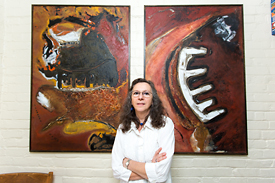What moment in the classroom stands out as the most memorable?
Memorable moments are when I realize that through a class experience students discover something fundamental. As part of a course on sustainable development related to hydropower projects proposed in Chilean Patagonia, a student pointing down at the Baker River valley said to me almost in tears: “Last year for a project design in an engineering class I placed a dam right there. I know now I was wrong.”
What can’t you live without?
Love.
What are your favorite spots near campus?
U-M Museum of Art, The Arboretum, Kerrytown.
What inspires you?
Nature, music.
What are you currently reading?
“Children’s Picturebooks: The art of visual storytelling” by Sallsbury and Styles.
Who had the greatest influence on your career path?
My adviser, Professor Jorge Artigas at the University of Concepcion, who is a scientist and an artist, and encouraged me to question all that did not make sense.
Adorning the brick walls of Sara Adlerstein’s office are two large canvases she painted in dark earth tones, reminiscent of rustic cave paintings.
“I have gone through a journey to understand how the natural sciences and art complement each other,” says Adlerstein, a research scientist at the School of Natural Resources and Environment.
Receiving her first Master of Science degree in Chile, Adlerstein initially was unsure what type of degree to pursue. “I’m somebody who is in love with too many things. I applied to programs for journalism, biology and visual arts but I decided to study biology and do art on my own,” says Adlerstein, whose artwork primarily consists of oil paintings with vibrant colors, sharp edges and thick textures.
“The fact that I’m an artist has influenced the way I do things in science … in science you learn rules that you have to follow, but it can be constraining, whereas art is freedom in thinking. By being an artist I can approach science in a different way that allows me to break the rules and find solutions I wouldn’t have found otherwise,” she says.
To encourage the integration of the arts and environmental sciences at U-M, Adlerstein obtained funds from the Office of the Vice President for Research and organized a two-day Arts and the Environment Colloquium event at the U-M Museum of Art, which facilitated a dialogue among artists scientists and community organizers.

Photo by Eric Bronson, Michigan Photography.
“I teach creativity across disciplines and most of what I teach isn’t from a book. I try to bring scientific information to the students in the art school, and I try to encourage creativity when I teach courses in science,” says Adlerstein, who is also pursuing collaboration with other faculty members within U-M to create a joint program combining the arts and environmental sciences.
In another attempt to create a bridge between the environment and the arts, Adlerstein has started an art gallery at the School of Natural Resources and Environment for works that can serve as conversation pieces within the mission of the school. Adlerstein’s art will be on display during November.
Besides allowing her art to inspire her scientific work and goals, Adlerstein’s work inspires her art as well. “Right now my research is about aquatic ecology and environmental stressors in the Great Lakes, so water is my focus, and my concerns about the region and the environment,” says Adlerstein who had a digital exhibit, called “We are Water” on display this past summer at the Shapiro Library.
But her main focus is contribute to improving education and to reach out to students studying sciences who feel they need to hide their artistic side to be taken seriously in the scientific world, and reach out to students who don’t integrate creativity into their work. “It’s human creativity, not technology that’s going to solve some of the main issues threatening our planet,” Adlerstein says.
The weekly Spotlight features faculty and staff members at the university. To nominate a candidate, please contact the Record staff at [email protected].

